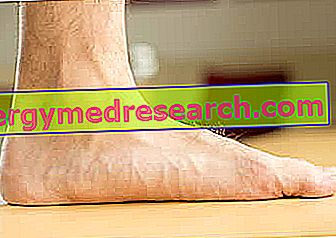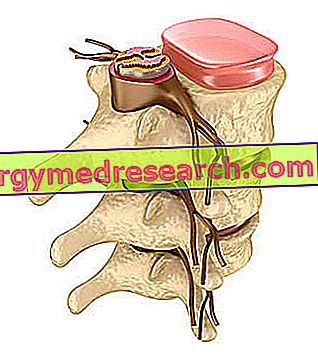Generality
The feet are defined flat when they have a lower medial arch than the normal or completely absent.
Consequently, those who suffer from this anatomical alteration have feet whose inner central part rests completely, or almost, on the ground.

When present, the most common symptoms are: foot pain, ankle pain, knee pain and overpronation.
For a correct diagnosis, physical examination and medical history are often sufficient.
Treatment depends on the severity of the symptoms: for less serious cases, conservative therapy may suffice; for more severe cases, surgery is required.
A brief reference to what the medial arch is
As you can see from the image below, the feet of the human being have, on the inner edge, a raised area that is detached from the support with the ground. This raised area is called the medial arch or internal longitudinal arch .
The height of the medial arch - ie how far the raised area comes off the ground - varies from person to person.
What are flat feet?
The flat feet - also known with the terminology in the singular form of the flat foot - are an anatomical malformation, in the presence of which an individual's feet have a lower medial arch than the normal or completely absent.
In people with normal feet, the central inner part of the feet does not rest on the ground: the presence of a plantar arch of the right height guarantees a correct weight distribution of the body, on the foot, and a better effectiveness in walking (it is less expensive) . All this entails a lower risk of musculoskeletal damage to the lower limbs and to the feet in particular.
In people with flat feet, on the other hand, the central inner part of the feet rests entirely on the ground: this alters the weight distribution on the feet and predisposes the latter to painful and degenerative phenomena of the joints, muscles, bones and ligaments.
Flat feet are a generally bilateral malformation; however, in some circumstances they can only cover one foot.

DO CHILDREN HAVE FLAT FEET?
In very young children and up to a certain age of childhood, flat feet are a constant for at least two reasons:
- The plantar arch has yet to develop;
- In the feet there is a quantity of adipose tissue such as to make the internal longitudinal vault little visible.
During the normal growth path, the baby's feet are slimmed down and more and more accentuate the plantar arch.
Causes
The flat foot can be a congenital condition, transmitted by one of the parents as a somatic characteristic, or an adaptive condition, following the presence of certain favoring factors.
Among the possible factors favoring flat feet of adaptive nature, include:
- Foot or ankle trauma;
- Neurological or neuromuscular disorders, such as spina bifida, cerebral palsy or muscular dystrophy;
- Connective tissue disorders, such as Ehlers-Danlos syndrome or joint hypermobility syndrome;
- An error in the formation of the bones of the foot, during uterine development;
- Obesity and overweight;
- Rheumatoid arthritis;
- Aging;
- Diabetes;
- Wrong postural habits;
- The use of inadequate footwear;
- Long periods of inactivity;
- A state of pregnancy. In this case, the effects are temporary.
Symptoms and Complications
To learn more: Flat Foot Symptoms
In general, the presence of flat feet is not associated with particular symptoms.
In those cases in which the absence of the plantar arch is symptomatic, the most common disorders are: pain in the feet (in particular on the heel or at the level of the central part), pain in the ankles, pain in the lower part of the legs, pain in the knees, pain in the hips, lower back pain, overpronation, swelling of the inside of the ankles and musculoskeletal problems at the feet.
MEANING OF HYPERPRONATION
Premise: the term pronation represents the rotation that the foot performs towards the inside immediately after resting on the ground. This moment is called the initial contact and is part of the step of supporting the gait cycle.
The experts on foot support speak of overpronation (or excessive pronation), when the foot, during the support phase, rotates excessively inwards or rotates at a time when it should not.
Excessive pronation shifts the weight of the body to the inner (or medial) side of the foot, rather than over the entire plant. In other words, during walking and especially running, a person with overpronation focuses all body weight exclusively on the inner edge of the feet.
All this destabilizes the foot, which will try to regain stability with a movement opposite to that imposed by the rotation towards the inside. This attempt affects the biomechanical efficiency of the leg, particularly of the knee and hip.
WHEN TO REFER TO THE DOCTOR?
The condition known as flat feet makes it necessary to consult a doctor when:
- The feet or any other part of the lower limb are painful, in spite of insoles properly inserted in the shoes;
- The footwear worn is consumed very quickly on the inside edge of the foot, due to excessive overpronation;
- The feet are completely missing from the plantar arch. In these circumstances, the entire plant rests on the ground;
- The feet give the feeling of being weak, rigid and insensitive.
Very often, it is also essential to consult a podiatra, ie a foot disease specialist, and an orthopedist, that is a doctor who specializes in the diagnosis, treatment and prevention of pathologies of the complex system of muscles, bones, tendons, ligaments and nerves, present in the human body.
Diagnosis
For a diagnosis of flat feet are sufficient, very often the physical examination and the anamnesis.
Doctors consider the use of additional diagnostic tests when the patient complains of intense symptoms (intense pain in the foot, ankle and / or knee).

OBJECTIVE AND ANAMNESIS EXAMINATION
The objective examination is the set of diagnostic maneuvers, carried out by the doctor, to verify the presence or absence, in the patient, of signs indicative of an abnormal condition. In the presence of a suspected condition of flat feet, the doctor observes the patient's feet from the front, from behind and during a walk.
The anamnesis is the collection and critical study of symptoms and facts of medical interest, reported by the patient or his family members (NB: family members are involved, above all, when the patient is very small).
X-RAY
X-rays on the feet produce images on the x-ray plate of bones and joints, present in the feet. They are very useful in identifying an arthritis condition (remember that rheumatoid arthritis is a possible factor favoring the flat foot).
The use of X-rays involves exposing the patient to a small amount of ionizing radiation that is harmful to human health. In all other respects, X-rays represent a painless test.
TAC
A CT scan on the feet allows images of the feet to be obtained from different angles and in greater detail than with X-rays.
The greater presence of details has its price: the exposure to ionizing radiations - which are used for the production of images - is definitely higher than that expected on X-ray occasions.
The execution of a CT scan is completely painless.
ULTRASOUND
An ultrasound on the feet allows the doctor to see what is the state of health of the soft tissues inside the feet. Besides being painless, it is also a completely non-invasive exam: the ultrasounds used for the production of images on a monitor are not at all harmful to human beings.
NUCLEAR MAGNETIC RESONANCE
Thanks to the creation of magnetic fields, a nuclear magnetic resonance at the feet provides detailed images of the soft tissues and hard tissues of the feet.
Besides being painless, it is also a completely non-invasive test: the magnetic fields used to create images are not at all harmful to the health of human beings.
Treatment
If they are asymptomatic (ie if they do not cause any kind of pain), flat feet do not require any special treatment.
If, on the other hand, they cause pain, depending on the severity of the symptoms, a doctor could opt for a non-surgical therapy (or conservative therapy) or for a surgical therapy.
NON-SURGICAL OR CONSERVATIVE THERAPY
As for non-surgical (or conservative) therapy, the possible treatments consist of:
- Use of podiatry foot orthoses (or simply orthotics). Podological foot orthoses are modeled on the patient's foot;
- Stretching exercises (or muscle stretching) for all the muscles of the leg that refer to the Achilles tendon;
- Use of orthopedic shoes for flat feet;
- Physiotherapy exercises for the improvement of walking technique and running technique. In general, doctors subject patients who practice sports - including, in particular, running, running, walking, etc. - to this type of treatment with a certain continuity;
- A diet program for weight reduction . Obviously, this treatment is reserved for overweight or obese patients;
- The administration of pain - relieving drugs, to reduce the painful sensation;
- A period of rest from all those activities that favor the appearance of pain (eg: running, long walks etc.). Alternatively, doctors recommend cycling or swimming.
Readers are reminded that conservative therapy is not a cure for flat feet, but a remedy to alleviate symptoms.
SURGICAL THERAPY
Doctors consider surgery for flat feet, when conservative therapy has proved ineffective (or has not provided the desired results) and the symptoms are very intense.
The details of the flat-foot operation vary depending on the anatomical changes responsible for the anomaly. On the basis of this, it is possible to state that each patient represents a case in itself, treated differently from anyone else.
As with any surgical operation, even in the case of flat-foot surgery, the patient will undergo a series of specific pre-operative examinations.
Prevention
Keeping body weight under control, being consistent in physical activity, wearing comfortable and well-made footwear and correcting any incorrect postural behavior are the main preventive measures for flat feet.



